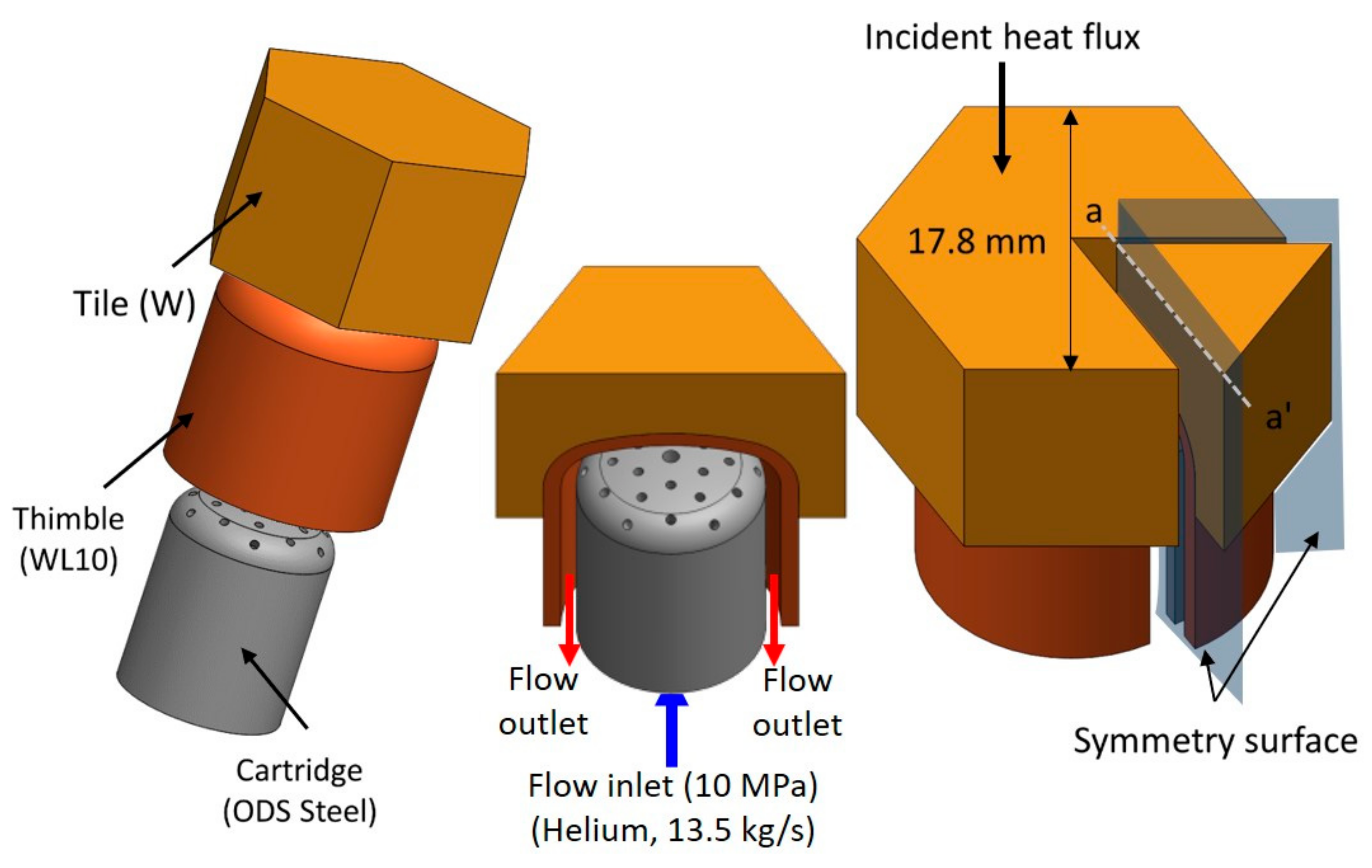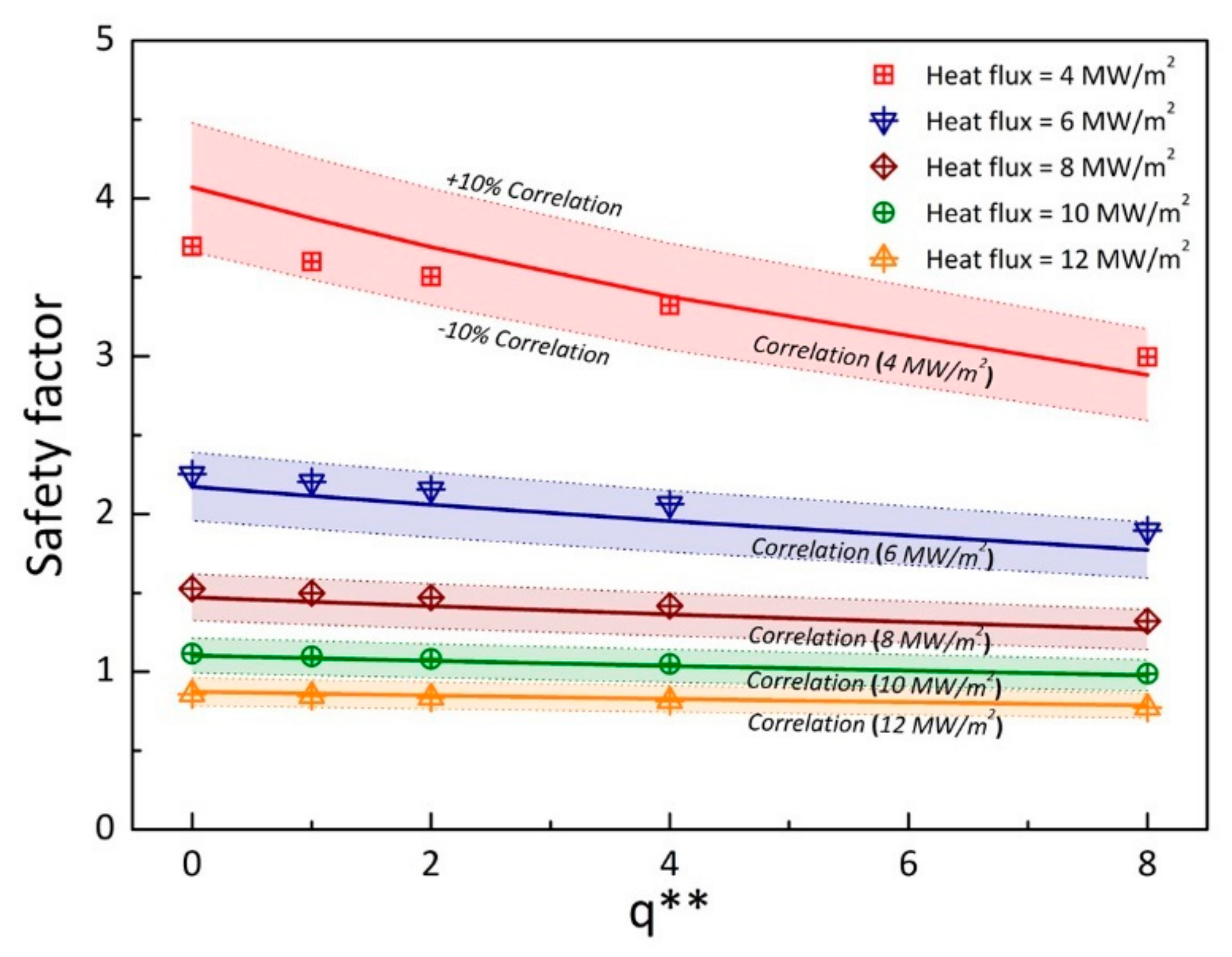Heat-Absorbing Capacity of High-Heat-Flux Components in Nuclear Fusion Reactors
Abstract
:1. Introduction
2. Material and Methods
2.1. Geometry and Configuration of Multi-Array Impingement Jet Modules
2.2. Numerical Details
2.2.1. Modeling of the Thermo-Hydraulic Analysis
2.2.2. Grid Formation and Validation
2.3. Analytical Approach
3. Results and Discussions
3.1. Heat Generation Effect on the Maximum Thimble Temperature
3.2. Thermomechanical Behavior Caused by Heat Generation Rate
3.3. Heat-Absorbing Capacity for the Satisfaction of System Reliability
4. Conclusions
Author Contributions
Funding
Acknowledgments
Conflicts of Interest
References
- Norajitra, P. Divertor Development for a Future Fusion Power Plant; KIT Scientific Publishing: Karlsruhe, Germany, 2014. [Google Scholar]
- Bagryansky, P.A.; Gospodchikov, E.D.; Ivanov, A.A.; Lizunov, A.A.; Kolesnikov, E.Y.; Konshin, Z.E.; Korobeynikov, O.A.; Kovalenko, Y.V.; Maximov, V.V.; Murakhtin, S.V.; et al. Studies of Plasma Confinement and Stability in a Gas Dynamic Trap: Results of 2016-2018. Plasma Fus. Res. 2019, 14, 2402030. [Google Scholar] [CrossRef]
- Tamura, H.; Goto, T.; Yanagi, N.; Miyazawa, J.; Tanaka, T.; Sagara, A.; Ito, S.; Hashizume, H. Effect of coil configuration parameters on the mechanical behavior of the superconducting magnet system in the helical fusion reactor FFHR. Fus. Eng. Des. 2019, in press. [Google Scholar] [CrossRef]
- Lei, M.; Song, Y.; Ye, M. Thermal hydraulic analysis of the HECLIC blanket breeder unit for CFETR. Int. J. Energy Res. 2015, 39, 370–376. [Google Scholar] [CrossRef]
- Lei, M.; Xu, S.; Guo, C.; Liu, S.; Song, Y.; Lu, K.; Pei, K.; Xu, K. Design and thermal-hydraulic evaluation of helium-cooled ceramic breeder blanket for China fusion engineering test reactor. Int. J. Energy Res. 2018, 42, 1657–1663. [Google Scholar] [CrossRef]
- Tejado, E.; Müller, A.V.; You, J.H.; Pastor, J.Y. Evolution of mechanical performance with temperature of W/Cu and W/CuCrZr composites for fusion heat sink applications. Mater. Sci. Eng. A 2018, 712, 738–746. [Google Scholar] [CrossRef] [Green Version]
- Coenen, J.W.; Mao, Y.; Sistla, S.; Müller, A.V.; Pintsuk, G.; Wirtz, M.; Riesch, J.; T Hoeschen, A.T.; Terraa, A.; You, J.H.; et al. Materials development for new high heat-flux component mock-ups for DEMO. Fusion Eng. Des. 2019, 146, 1431–1436. [Google Scholar] [CrossRef]
- You, J.; Visca, E.; Barrett, T.; Böswirth, B.; Crescenzi, F.; Domptail, F.; Fursdon, M.; Gallay, F.; Ghidersa, B.; Greuner, H.; et al. European divertor target concepts for DEMO: Design rationales and high heat flux performance. Nucl Mat. Energy 2018, 16, 1–11. [Google Scholar] [CrossRef]
- Rindt, P.; Morgan, T.W.; Jaworski, M.A.; Cardozo, N.J.L. Power handling limit of liquid lithium divertor targets. Nucl. Fusion 2018, 58, 104002. [Google Scholar] [CrossRef] [Green Version]
- Yuan, W.; Zhao, J.; Tso, C.P.; Wu, T.; Liu, W.; Ming, T. Numerical simulation of the thermal hydraulic performance of a plate pin fin heat sink. Appl. Eng. 2012, 48, 81–88. [Google Scholar] [CrossRef]
- Zhao, J.; Huang, S.; Gong, L.; Huang, Z. Numerical study and optimizing on micro square pin-fin heat sink for electronic cooling. Appl. Eng. 2016, 93, 1347–1359. [Google Scholar] [CrossRef]
- Park, J.S.; Kim, K.M.; Lee, D.H.; Cho, H.H.; Chyu, M. Heat Transfer in Rotating Channel with Inclined Pin-Fins. J. Turbomach. 2011, 133, 021003. [Google Scholar] [CrossRef]
- Kim, K.M.; Lee, D.H.; Cho, H.H. Pressure drop and thermal performance in rotating two-pass ducts with various cross rib arrangements. Heat Mass Trans. 2007, 44, 913–919. [Google Scholar] [CrossRef]
- Kim, K.M.; Lee, H.; Kim, B.S.; Shin, S.; Lee, D.H.; Cho, H.H. Optimal design of angled rib turbulators in a cooling channel. Heat Mass Trans. 2009, 45, 1617–1625. [Google Scholar] [CrossRef]
- Ma, T.; Wang, Q.-W.; Zeng, M.; Chen, Y.-T.; Liu, Y.; Nagarajan, V. Study on heat transfer and pressure drop performances of ribbed channel in the high temperature heat exchanger. Appl. Energy 2012, 99, 393–401. [Google Scholar] [CrossRef]
- Han, B.; Goldstein, R. Jet-Impingement Heat Transfer in Gas Turbine Systems. Ann. N. Y. Acad. Sci. 2001, 934, 147–161. [Google Scholar] [CrossRef] [PubMed]
- Hong, S.K.; Lee, D.H.; Cho, H.H. Effect of jet direction on heat/mass transfer of rotating impingement jet. Appl. Therm. Eng. 2009, 29, 2914–2920. [Google Scholar] [CrossRef]
- Wang, B.; Lin, D.; Xie, Q.; Wang, Z.; Wang, G. Heat transfer characteristics during jet impingement on a high-temperature plate surface. Appl. Therm. Eng. 2016, 100, 902–910. [Google Scholar] [CrossRef]
- Whelan, B.P.; Kempers, R.; Robinson, A.J. A liquid-based system for CPU cooling implementing a jet array impingement waterblock and a tube array remote heat exchanger. Appl. Eng. 2012, 39, 86–94. [Google Scholar] [CrossRef]
- Wu, S.-J.; Shin, C.H.; Kim, K.M.; Cho, H.H. Single-phase convection and boiling heat transfer: Confined single and array-circular impinging jets. Int. J. Multiph. Flow 2007, 33, 1271–1283. [Google Scholar] [CrossRef]
- Shin, C.H.; Kim, K.M.; Lim, S.H.; Cho, H.H. Influences of nozzle-plate spacing on boiling heat transfer of confined planar dielectric liquid impinging jet. Int. J. Heat Mass Trans. 2009, 52, 5293–5301. [Google Scholar] [CrossRef]
- Shin, S.; Choi, G.; Kim, B.S.; Cho, H.H. Flow boiling heat transfer on nanowire-coated surfaces with highly wetting liquid. Energy 2014, 76, 428–435. [Google Scholar] [CrossRef]
- Tahat, M.; Kodah, Z.; Jarrah, B.; Probert, S. Heat transfers from pin-fin arrays experiencing forced convection. Appl. Energy 2000, 67, 419–442. [Google Scholar] [CrossRef]
- Bi, C.; Tang, G.H.; Tao, W.Q. Heat transfer enhancement in mini-channel heat sinks with dimples and cylindrical grooves. Appl. Eng. 2013, 55, 121–132. [Google Scholar] [CrossRef]
- Yang, J.; Pais, M.R.; Chow, L.C. Critical Heat Flux Limits in Secondary Gas Atomized Liquid Spray Cooling. Exp. Heat Trans. 1993, 6, 55–67. [Google Scholar] [CrossRef]
- Hsieh, S.-S.; Fan, T.-C.; Tsai, H.-H. Spray cooling characteristics of water and R-134a. Part I: Nucleate boiling. Int. J. Heat Mass Trans. 2004, 47, 5703–5712. [Google Scholar] [CrossRef]
- Kim, J. Spray cooling heat transfer: The state of the art. Int. J. Heat Fluid Flow. 2007, 28, 753–767. [Google Scholar] [CrossRef]
- Weathers, J.B.; Crosatti, L.; Kruessmann, R.; Sadowski, D.L.; Abdel-Khalik, S.I. Development of modular helium-cooled divertor for DEMO based on the multi-jet impingement (HEMJ) concept: Experimental validation of thermal performance. Fus. Eng. Des. 2008, 83, 1120–1125. [Google Scholar] [CrossRef]
- Rader, J.D.; Mills, B.H.; Sadowski, D.L.; Yoda, M.; Abdel-Khalik, S.I. Verification of thermal performance predictions of prototypical multi-jet impingement helium-cooled divertor module. Fus. Sci. Technol. 2013, 64, 282–287. [Google Scholar] [CrossRef]
- Jung, H.-Y.; Kim, K.-Y. Thermal-hydraulic performance of a multiple jet cooling module with a concave dimple array in a helium-cooled divertor. Fus. Eng Des. 2017, 114, 102–112. [Google Scholar] [CrossRef]
- Hermsmeyer, S.; Kleefeldt, K. Review and Comparative Assessment of Helium-Cooled Divertor Concepts; Forschungszentrum: Karlsruhe, Germany, 2001. [Google Scholar]
- Ovchinnikov, I.; Giniyatulin, R.; Ihli, T.; Janeschitz, G.; Komarov, A.; Kruessmann, R.; Kuznetsov, V.; Mikhailov, S.; Norajitra, P.; Smirnov, V. Experimental study of DEMO helium cooled divertor target mock-ups to estimate their thermal and pumping efficiencies. Fus. Eng. Des. 2005, 73, 181–186. [Google Scholar] [CrossRef]
- Krüßmann, R.; Messemer, G.; Zinn, K. Overview of Thermohydraulic Simulations for the Development of a Helium-Cooled Divertor; Forschungszentrum: Karlsruhe, Germany, 2008. [Google Scholar]
- Lee, N.; Lim, J.-S.; Ghidersa, B.; Cho, H.H. Nozzle-to-target distance effect on the cooling performances of a jet-impingement helium-cooled divertor. Fus. Eng Des. 2018, 136, 803–808. [Google Scholar] [CrossRef]
- Lim, J.-S.; Lee, N.; Ghidersa, B.-E.; Cho, H.H. Enhancement of cooling performance of a helium-cooled divertor through the addition of rib structures on the jet-impingement area. Fus. Eng. Des. 2018, 136, 655–660. [Google Scholar] [CrossRef]
- Materna-Morris, E.; Lindau, R.; Schneider, H.-C.; Möslang, A. Tensile behavior of EUROFER ODS steel after neutron irradiation up to 16.3 dpa between 250 and 450 °C. Fus. Eng. Des. 2015, 98–99, 2038–2041. [Google Scholar] [CrossRef]
- Hasegawa, A.; Fukuda, M.; Yabuuchi, K.; Nogami, S. Neutron irradiation effects on the microstructural development of tungsten and tungsten alloys. J. Nucl. Mat. 2015, 471, 175–183. [Google Scholar] [CrossRef]
- Gilbert, M.; Dudarev, S.; Zheng, S.; Packer, L.; Sublet, J.-C. An integrated model for materials in a fusion power plant: Transmutation, gas production, and helium embrittlement under neutron irradiation. Nucl. Fus. 2012, 52, 083019. [Google Scholar] [CrossRef]
- Batistoni, P.; Fischer, P.U.; Ochiai, K.; Petrizzi, L.; Seidel, K.; Youssef, M. Neutronics and nuclear data issues in ITER and their validation. Fus. Eng. Des. 2008, 83, 834–841. [Google Scholar] [CrossRef]
- Serikov, A.; Fischer, U.; Große, D.; Heidinger, R.; Spah, P.; Strauß, D. Nuclear-safety-related and shielding analyses of the ITER quasi-optical ECH launcher. IEEE Trans. Plasma Sci. 2010, 38, 224–231. [Google Scholar] [CrossRef]
- Serikov, A.; Fischer, U.; Grosse, D. High performance parallel Monte Carlo transport computations for ITER fusion neutronics applications. Prog. Nucl. Sci. Tech. 2011, 2, 294–300. [Google Scholar] [CrossRef]
- Lee, N.; Kim, B.S.; Kim, T.; Bae, J.-Y.; Cho, H.H. Thermal design of helium cooled divertor for reliable operation. Appl. Eng. 2017, 110, 1578–1588. [Google Scholar] [CrossRef]
- Norajitra, P.; Giniyatulin, R.; Ihli, T.; Janeschitz, G.; Karditsas, P.; Krauss, W.; Kruessmann, R.; Kuznetsov, V.; Maisonnier, D.; Mazul, I.; et al. European development of He-cooled divertors for fusion power plants. Nucl. Fus. 2005, 45, 1271–1276. [Google Scholar] [CrossRef]
- Končar, B.; Norajitra, P.; Oblak, K. Effect of nozzle sizes on jet impingement heat transfer in He-cooled divertor. Appl. Therm. Eng. 2010, 30, 697–705. [Google Scholar] [CrossRef] [Green Version]
- ANSYS. ANSYS CFX-Solver Theory Guide; ANSYS: Canonsburg, PN, USA, 2013. [Google Scholar]
- Zuckerman, N.; Lior, N. Jet Impingement Heat Transfer: Physics, Correlations, and Numerical Modeling. Adv. Heat Transf. 2006, 39, 565–631. [Google Scholar]
- Končar, B.; Draksler, M.; Oblak, K.; Norajitra, P.; Widak, V. Numerical investigation of multiple-jet cooling concept for helium cooled divertor. In Proceedings of the International Conference Nuclear Energy for New Europe, Portoroz, Slovenia, 8–11 September 2008. [Google Scholar]
- NIST. Thermophysical Properties of Fluid Systems. Available online: http://webbook.nist.gov/chemistry/fluid/ (accessed on 1 October 2018).
- Davis, J.; Smith, P. ITER material properties handbook. J. Nucl. Mat. 1996, 233, 1593–1596. [Google Scholar] [CrossRef]
- Kruessmann, R.; Norajitra, P. Conceptual Design of a He-Cooled Divertor with Integrated Flow and Heat Transfer Promoters (PPCS Subtask TW3-TRP-001-D2): Part II: Detailed Version; Forschungszentrum: Karlsruhe, Germany, 2004. [Google Scholar]
- Kreyszig, E.; Norminton, E.J. Advanced Engineering Mathematics; John Wiley: New York, NY, USA, 2006. [Google Scholar]
- Çengel, Y.A.; Ghajar, A.J. Heat and Mass Transfer: Fundamentals & Applications; McGraw-Hill: New York, NY, USA, 2011. [Google Scholar]
- Hwang, S.D.; Cho, H.H. Effects of acoustic excitation positions on heat transfer and flow in axisymmetric impinging jet: Main jet excitation and shear layer excitation. Int. J. Heat Fluid Flow. 2003, 24, 199–209. [Google Scholar] [CrossRef]
- Brooks, J.; Cha, Y.; Hassanein, A.; Majumdar, S.; Mattas, R.; Smith, D. Engineering Design of a Liquid Metal Cooled Self-Pumped Limiter for a Tokamak Reactor; Argonne National Lab: Lemont, IL, USA, 1987.
- Kim, K.M.; Shin, S.; Lee, D.H.; Cho, H.H. Influence of material properties on temperature and thermal stress of thermal barrier coating near a normal cooling hole. Int. J. Heat Mass Trans. 2011, 54, 5192–5199. [Google Scholar] [CrossRef]
- Moon, H.; Kim, K.M.; Jeon, Y.H.; Shin, S.; Park, J.S.; Cho, H.H. Effect of thermal stress on creep lifetime for a gas turbine combustion liner. Eng. Fail. Anal. 2015, 47, 34–40. [Google Scholar] [CrossRef]
- Ullman, D.G. The Mechanical Design Process; McGraw-Hill: New York, NY, USA, 1992. [Google Scholar]









© 2019 by the authors. Licensee MDPI, Basel, Switzerland. This article is an open access article distributed under the terms and conditions of the Creative Commons Attribution (CC BY) license (http://creativecommons.org/licenses/by/4.0/).
Share and Cite
Lee, N.; Kim, B.S.; Moon, H.; Lim, J.-S.; Cho, H.H. Heat-Absorbing Capacity of High-Heat-Flux Components in Nuclear Fusion Reactors. Energies 2019, 12, 3771. https://doi.org/10.3390/en12193771
Lee N, Kim BS, Moon H, Lim J-S, Cho HH. Heat-Absorbing Capacity of High-Heat-Flux Components in Nuclear Fusion Reactors. Energies. 2019; 12(19):3771. https://doi.org/10.3390/en12193771
Chicago/Turabian StyleLee, Namkyu, Beom Seok Kim, Hokyu Moon, Joon-Soo Lim, and Hyung Hee Cho. 2019. "Heat-Absorbing Capacity of High-Heat-Flux Components in Nuclear Fusion Reactors" Energies 12, no. 19: 3771. https://doi.org/10.3390/en12193771



